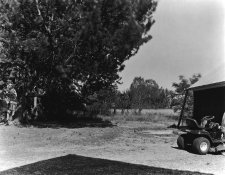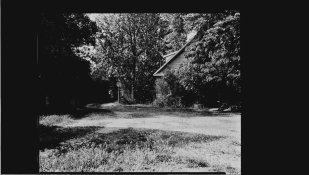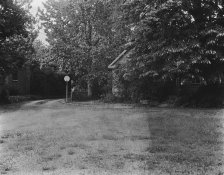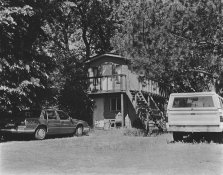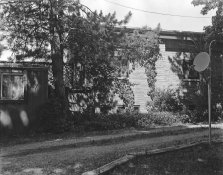I recently resumed experimenting with homebrew developers after a long period of not doing anything in photography. I've read about Jim Galli's diluted Rodinal with added restrainer developer and viewed some of the linked images, and they're impressive.
But I wanted to see what I could come up with from my stock of dry raw chems, and I don't have any Rodinal on hand. Metol and sodium sulfite were picked because D-23 has a reputation for not blowing out highlights and not producing contrasty negatives. Instead of mixing a batch of D-23 and diluting it, the ingredients were mixed at tray dilution and different concentrations of ingredients and development times were tried.
I figured, if D-23 has fairly low activity with a high concentration of sodium sulfite, it might have somewhat lower activity if just enough sulfite was added to prevent oxidation of the metol during the processing session. A low concentration of metol might help with the very contrasty litho films.
What I'm using now is:
1000 ml water
A pinch of sodium sulfite to prevent oxidation of the metol
2 grams metol
10 grams sodium sulfite
Development time is about two and a half minutes at 70 deg F.
I started shooting the Arista Ortho Litho film at about ISO 2, but wasn't getting any shadow detail. So exposures were gradually increased and development shortened a bit. What's that old saying, "Expose for the shadows, develop for the highlights"?
I ended up with an exposure of 6 seconds at f32 in slightly hazy sun, resulting in an ISO of about 0.7 or so. Some of the negs have decent shadow detail.
Uneven development of negatives with edges darker than the center was a problem when the negatives were being developed in 8X10 trays. I tried different agitation methods including sliding the film out and back into the developer, but the dark edges persisted. Then tried larger trays, food storage containers from the big box store. This helped, but not completely.
Finally, I went for total overkill and bought a 16X20 tray for development. I had to mix two liters of developer to cover the tray bottom.
Upside - Uneven development all gone! A gentle agitation is all that's needed to get the 8X10 negative sliding around in the tray, from end to end and side to side. Easy as pie.
Downside - Uses lots of chemistry. But this isn't really so bad, because when litho films are developed for continuous tones, the developers are usually very dilute.
Equipment: Seneca Improved View, 8X10. The first image was shot with a beater 12" Dagor in an Ilex #4 shutter. Exposure was 6 seconds at f32 in slightly hazy sun. Film was an old batch of Arista Ortho Litho film bought in 2001. Contact printed on Ilford MG IV FB paper, scan of print.
The second image was shot with the same camera and a recently acquired Turner-Reich triple in 12"/19.7"/25" f7.0. Exposure was 8 seconds at f32. Film was a more recent batch of Arista APHS only about 2 years old. Little shadow detail, as the shadows were darker than in the first scene. Negative scan on a flatbed scanner. The scanned image is contrastier than I think a print will be.
This will be a lot of fun, but I don't think I'll ever get the same tonality as a film designed for continuous tone in-camera negatives. The litho film is just designed for completely different work.
But I wanted to see what I could come up with from my stock of dry raw chems, and I don't have any Rodinal on hand. Metol and sodium sulfite were picked because D-23 has a reputation for not blowing out highlights and not producing contrasty negatives. Instead of mixing a batch of D-23 and diluting it, the ingredients were mixed at tray dilution and different concentrations of ingredients and development times were tried.
I figured, if D-23 has fairly low activity with a high concentration of sodium sulfite, it might have somewhat lower activity if just enough sulfite was added to prevent oxidation of the metol during the processing session. A low concentration of metol might help with the very contrasty litho films.
What I'm using now is:
1000 ml water
A pinch of sodium sulfite to prevent oxidation of the metol
2 grams metol
10 grams sodium sulfite
Development time is about two and a half minutes at 70 deg F.
I started shooting the Arista Ortho Litho film at about ISO 2, but wasn't getting any shadow detail. So exposures were gradually increased and development shortened a bit. What's that old saying, "Expose for the shadows, develop for the highlights"?
I ended up with an exposure of 6 seconds at f32 in slightly hazy sun, resulting in an ISO of about 0.7 or so. Some of the negs have decent shadow detail.
Uneven development of negatives with edges darker than the center was a problem when the negatives were being developed in 8X10 trays. I tried different agitation methods including sliding the film out and back into the developer, but the dark edges persisted. Then tried larger trays, food storage containers from the big box store. This helped, but not completely.
Finally, I went for total overkill and bought a 16X20 tray for development. I had to mix two liters of developer to cover the tray bottom.
Upside - Uneven development all gone! A gentle agitation is all that's needed to get the 8X10 negative sliding around in the tray, from end to end and side to side. Easy as pie.
Downside - Uses lots of chemistry. But this isn't really so bad, because when litho films are developed for continuous tones, the developers are usually very dilute.
Equipment: Seneca Improved View, 8X10. The first image was shot with a beater 12" Dagor in an Ilex #4 shutter. Exposure was 6 seconds at f32 in slightly hazy sun. Film was an old batch of Arista Ortho Litho film bought in 2001. Contact printed on Ilford MG IV FB paper, scan of print.
The second image was shot with the same camera and a recently acquired Turner-Reich triple in 12"/19.7"/25" f7.0. Exposure was 8 seconds at f32. Film was a more recent batch of Arista APHS only about 2 years old. Little shadow detail, as the shadows were darker than in the first scene. Negative scan on a flatbed scanner. The scanned image is contrastier than I think a print will be.
This will be a lot of fun, but I don't think I'll ever get the same tonality as a film designed for continuous tone in-camera negatives. The litho film is just designed for completely different work.
Attachments
Last edited by a moderator:








